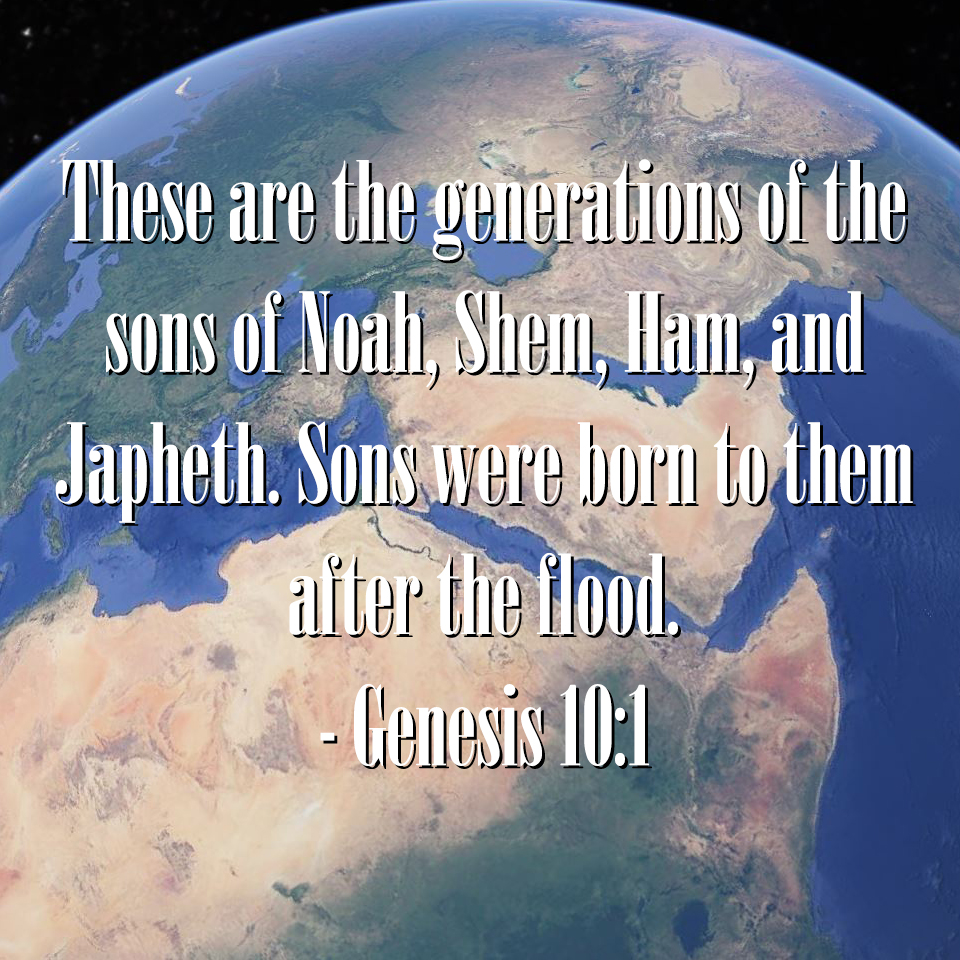
1 These are the generations of the sons of Noah, Shem, Ham, and Japheth. Sons were born to them after the flood.
This chapter begins with another “These are the generations of…” statement, marking a decisive shift in the narrative, and officially closing out the story of Noah. This chapter is the second major genealogy in Genesis, and is often called the table of nations, as many of the ancient kingdoms are identified in this list.
2 The sons of Japheth: Gomer, Magog, Madai, Javan, Tubal, Meshech, and Tiras. 3 The sons of Gomer: Ashkenaz, Riphath, and Togarmah. 4 The sons of Javan: Elishah, Tarshish, Kittim, and Dodanim. 5 From these the coastland peoples spread in their lands, each with his own language, by their clans, in their nations.
The genealogy starts with Japheth, who might very well be Noah’s youngest son, as he always appears last in the naming of the three sons. His genealogy is also the least extensive, paling in comparison to those of his brothers. The descendants of Japheth range from far Eurasia (Gomer, Magog, & Madai), Iran & Turkey (Tubal, Meshech, & Trias), and the northern Mediterranean (Javan & and his children). These groups probably extended to become the European and Eurasian peoples.
Notice also that the text refers to the peoples spreading out in their own lands with their own languages. The varying of languages does not come until the tower of Babel, which we will see in the next chapter. However this shows that after Babel languages seemed to fit within certain families and groups.
6 The sons of Ham: Cush, Egypt, Put, and Canaan.
Ham had four sons, and Canaan was likely the youngest, as he appears last in the list. Referencing chapter 9, this might explain why Noah cursed Canaan, “his youngest son” (Genesis 9:24)
7 The sons of Cush: Seba, Havilah, Sabtah, Raamah, and Sabteca. The sons of Raamah: Sheba and Dedan.
Cush seems to be the father of several people groups within the Arabian peninsula and North Eastern Africa.
8 Cush fathered Nimrod; he was the first on earth to be a mighty man. 9 He was a mighty hunter before the LORD. Therefore it is said, “Like Nimrod a mighty hunter before the LORD.” 10 The beginning of his kingdom was Babel, Erech, Accad, and Calneh, in the land of Shinar. 11 From that land he went into Assyria and built Nineveh, Rehoboth-Ir, Calah, and 12 Resen between Nineveh and Calah; that is the great city.
The inclusion of Nimrod seems odd, as he in not listed as one of Cush’s orginal sons, it is more likely that he was a more distant descendant. He also went a separate direction than most of Cush’s descendants, mentioning Babel (Babylon), Shinar, Assyria and Nineveh, places spread throughout Mesopotamia, not in Arabia nor Africa.
13 Egypt fathered Ludim, Anamim, Lehabim, Naphtuhim, 14 Pathrusim, Casluhim (from whom the Philistines came), and Caphtorim.
Egypt is possibly the most easily recognizable name in the entire list. His descendants are all listed in the plural in Hebrew, suggesting that there could of been several people groups from each of his sons.
While it is easy to assume that Egypt’s decedents were in northern Africa (modern day Egypt), they mention of the Philistines suggests that many of Egypt’s descendants could have been spread around the Mediterranean. The Philistines have been traced back to a people group from the Greek isles, and were a sea faring people, if they truly were descendants of Egypt, then it is plausible that many of his other descendants spread around the Mediterranean as well.
15 Canaan fathered Sidon his firstborn and Heth, 16 and the Jebusites, the Amorites, the Girgashites, 17 the Hivites, the Arkites, the Sinites, 18 the Arvadites, the Zemarites, and the Hamathites. Afterward the clans of the Canaanites dispersed. 19 And the territory of the Canaanites extended from Sidon in the direction of Gerar as far as Gaza, and in the direction of Sodom, Gomorrah, Admah, and Zeboiim, as far as Lasha. 20 These are the sons of Ham, by their clans, their languages, their lands, and their nations.
Canaan has the most extensive genealogy of the sons of Ham. His descendants became many of the tribes that Israel would come in contact with, the land currently known as Israel used to in fact be the land of Canaan. The Jebusites and the Amorites make numerous appearances throughout the biblical text.
Altogether, the descendants of Ham covered much of Africa, Arabia, and Mesopotamia.
21 To Shem also, the father of all the children of Eber, the elder brother of Japheth, children were born.
Shem’s genealogy focuses primarially on the line of Eber, father of the Hebrew people.
22 The sons of Shem: Elam, Asshur, Arpachshad, Lud, and Aram. 23 The sons of Aram: Uz, Hul, Gether, and Mash.
While some of these peoples can be better identified (such as the Arameans), many of Shem’s descendants are more difficult to place. Many of them seem to be in Mesopotamia and Arabia sharing space with some of Ham’s decedents.
24 Arpachshad fathered Shelah; and Shelah fathered Eber. 25 To Eber were born two sons: the name of the one was Peleg, for in his days the earth was divided, and his brother’s name was Joktan.
Peleg is a name that sounds similar to the Hebrew word for division. It is likely that he was born around the same time as the events of the tower of Babel. Peleg’s genealogy will be further explored later, as he ends up being the ancestor of the Israelites.
26 Joktan fathered Almodad, Sheleph, Hazarmaveth, Jerah, 27 Hadoram, Uzal, Diklah, 28 Obal, Abimael, Sheba, 29 Ophir, Havilah, and Jobab; all these were the sons of Joktan. 30 The territory in which they lived extended from Mesha in the direction of Sephar to the hill country of the east. 31 These are the sons of Shem, by their clans, their languages, their lands, and their nations.
The genealogy concludes with a description of the people groups descended from Joktan. It is not clear where many of these groups settled geographically, although the Arabian peninsula seems like a likely place.
32 These are the clans of the sons of Noah, according to their genealogies, in their nations, and from these the nations spread abroad on the earth after the flood.
With the conclusion of the genealogy, we are left with no clue as to the ancestors of the Oriental/Asian people groups, as there is no clear evidence that they are the children of any of Noah’s descendants. It is likely they formed from some group that was not extensively listed in the genealogy, possibly many years after the tower of Babel. Personally, I think they might have been some of the descendants of Shem, which were the hardest to places geographically. If this were the case then the European peoples would be descendants of Japheth, the African People descendants of Ham, the Asian peoples descendants of Shem, and the middle eastern peoples a mix of all three. However this is just a personal opinion, and there is little evidence to back it up. In any case, the genealogy ends with the beginning of people spreading throughout the earth.
